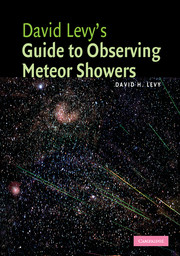Book contents
- Frontmatter
- Contents
- Preface
- 1 July 4, 1956
- 2 What is a meteor?
- 3 Some historical notes
- 4 Small rocks and dust in space
- 5 Observing meteors
- 6 Recording meteors
- 7 A New Year gift: the Quadrantids
- 8 The Lyrids – an April shower
- 9 The Eta Aquarids
- 10 The Omicron Draconids, continued
- 11 The Delta Aquarids
- 12 Tears of St. Lawrence: Perseid trails and trials
- 13 The August Pavonids
- 14 The Orionids
- 15 The Taurids
- 16 The Leonids
- 17 The Geminids
- 18 The Ursids
- 19 A catalog of meteor showers throughout the year
- Appendix
- Index
18 - The Ursids
Published online by Cambridge University Press: 06 July 2010
- Frontmatter
- Contents
- Preface
- 1 July 4, 1956
- 2 What is a meteor?
- 3 Some historical notes
- 4 Small rocks and dust in space
- 5 Observing meteors
- 6 Recording meteors
- 7 A New Year gift: the Quadrantids
- 8 The Lyrids – an April shower
- 9 The Eta Aquarids
- 10 The Omicron Draconids, continued
- 11 The Delta Aquarids
- 12 Tears of St. Lawrence: Perseid trails and trials
- 13 The August Pavonids
- 14 The Orionids
- 15 The Taurids
- 16 The Leonids
- 17 The Geminids
- 18 The Ursids
- 19 A catalog of meteor showers throughout the year
- Appendix
- Index
Summary
I shall fall
Like a bright exhalation in the evening,
And no man see me more.
With so much attention being paid to the Geminids peaking on December 13, we often forget the last major shower of the year, the Ursids. Discovered by the famous British astronomer William Denning around 1900, the shower was considered minor until the extraordinary night of December 22, 1945. Antonin Becvar was observing at the Skalnate Pleso Observatory in Czechoslovakia, and it was not hard to notice rising numbers of meteors coming from the north. He arranged for photographs to be taken and proper counts to be made of meteors coming from a radiant near Beta Ursae Minoris, the second brightest star in the Little Dipper after Polaris. A few years later Becvar became famous as the author of several star atlases, including the Skalnate Pleso Atlas of the Heavens, which served for most of the second half of the twentieth century as the leading star atlas for serious astronomers. Becvar also headed a most serious comet search program from Skalnate Pleso, which resulted in the discoveries of several comets from that site.
After his rediscovery of the Ursids, observations visual, photographic, and radar came within a few years. They are now considered a respectable meteor shower, the most recent of the major showers to be detected. Activity varies from year to year. Some years the rates may be below five per hour, but some years are far more favorable.
- Type
- Chapter
- Information
- David Levy's Guide to Observing Meteor Showers , pp. 100 - 102Publisher: Cambridge University PressPrint publication year: 2007



